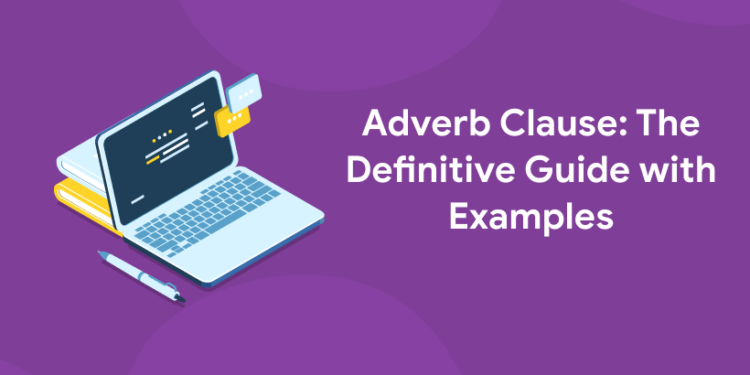Table of Contents
A sentence may make its meaning fully obvious yet still require a little further explanation. Use an adverb when you come across a statement like this in your work. That is why they exist in English. However, there are situations when a statement requires more than just an adverb. More context is needed to describe the what, where, why, and/or how of the main clause. You can either finish the sentence with another sentence or use an adverbial phrase in this circumstance.
Click here for the best tips to improve grammar skills in the English language
What is an Adverb?
Adverbs are parts of speech (or word classes) that are used to modify verbs, adjectives, or other adverbs, as well as prepositional phrases, subordinate clauses, and whole sentences. Adverbs are content words that convey information about how, when, or where something occurs. Because they amplify the meaning of the word or words they modify, adverbs are also known as intensifiers.
Click here to learn more details about adverbs and their functions
Types of Adverbs
An adverb that qualifies an adjective—as in quite sad—or another adverb—as in very carelessly—appears directly before the word it modifies, while one that modifies a verb is more flexible: It can appear before or after a verb, as in gently sang or softly sang, or at the start of a sentence, as in softly she sang to the infant, with the position of an adverb impacting the meaning of the sentence. Adverbs can change the meaning of a verb or adjective by adding information regarding emphasis, style, time, place, and frequency.
| Adverb | Description | Example |
| Adverbs of Emphasis | Adverbs of emphasis are employed to provide more intensity or surety to another word in a sentence, or the sentence as a whole. | Certainly, clearly, naturally, absolutely, definitely, obviously, positively, really, simply, and undoubtedly |
| Adverbs of Manner | Manner adverbs describe how something is done. They’re frequently at the end of a sentence or right before the main verb. | quietly, fitfully, quickly. Lowly, patiently carefully |
| Adverbs of Time | Time adverbs tell you when or when something is completed. Time adverbs are typically used towards the end of a sentence. They can also be used before a comma at the beginning of a sentence. Other temporal phrases, such as days of the week, are used with these adverbs. | already, yesterday, tomorrow, next week, last week, now, ago |
| Adverbs of Place | Place adverbs show where something is done and are normally used at the end of a sentence, but they can also exist before or after the verb. Prepositional phrases like in the doorway or at the shop can be confused with adverbs of place. Prepositional phrases tell you where something is, but place adverbs tell you where it happens. | Here, downstairs, Over there, everywhere |
| Adverbs of Frequency | Frequency adverbs describe how frequently something is repeated. Frequency adverbs are normally placed before the main verb. In the negative or question form, adverbs of frequency that express infrequency are not utilised. Frequency adverbs are sometimes used at the start of a statement. The verb to be is followed by adverbs of frequency. | usually, sometimes, never, often, rarely, sometimes, often |
Register for the best English courses to learn more about various kinds of clauses
What is a Clause?
1: Which of the sentences below is grammatically correct?
A sentence is a sequence of words that, on their own, make complete meaning. We may be familiar with phrases as well. A phrase, unlike a sentence, is a collection of words that lacks a subject, a predicate, or a finite verb, and is not independently meaningful. Clauses can be thought of as being in the middle of sentences and phrases. A clause, in technical terms, is a group of words with its own subject, predicate, and finite verb that may or may not be independently meaningful.
Types of Clauses
There are two sorts of clauses: principal or independent clauses and subordinate or dependent clauses.
Independent Clause or Principal Clause
An independent clause is a set of words that consists of a subject, predicate, and finite verb that can stand alone. So, what distinguishes it from a sentence? That’s right, it doesn’t. An independent clause can be used in place of a sentence. Because independent clauses are full sentences in themselves, they cannot be employed as nouns, adverbs, or adjectives. Let’s have a look at some examples.
- It is dark.
- You should leave.
Dependent Clause or Subordinate Clause
Dependent clauses, as the name implies, require an independent clause to fulfil their meaning. A dependent clause, like the main clause, has a subject, a predicate, and a finite verb, but it has no meaning by itself. It’s important to understand that, like phrases, dependent clauses can be employed as a noun, adverbs, or adjectives. The different types of dependent clauses are:
- Noun clause
- Adjective clause
- Adverb clause
Click here to attend some practice questions on the topic “clauses”
Adverb Clause: The Definitive Guide with Examples
A dependent clause that modifies a verb, adjective, or adverb in its sentence is known as an adverbial clause. An adverbial clause, in other words, is a clause that performs the same function as an adverb.
What is an Adverbial Clause?
An adverbial clause, also known as an adverb clause, is a group of words that operate as an adverb when used together. The clause describes or modifies a verb, adjective, or another adverb in this way. Adverbial clauses, unlike other types of clauses, are always dependent clauses. This indicates it can’t stand on its own as a complete sentence. Adverbial clauses enrich sentences by adding context and detail that traditional adverbs cannot.
Examples: He bakes cookies weekly.
Eagerly, my sister concurred with the business proposal.
Adverbial clauses can come at any position in a sentence, as shown in these instances. They can be literal or symbolic. Every aspect of speech, as well as every phrase and clause, is a device with a specific function in mind. Use an adverb when you need to write a short sentence. Use an adverbial clause when you need more information.
Grab the latest notes on adverbial clauses
Types of Adverbial Clauses
Many distinct types of adverbial clauses exist. The nature of the information communicated by the phrase defines each of these forms.
Adverbial Clause of Manner
An adverbial clause of manner describes how the action mentioned in the main clause of the sentence is occurring or occurred earlier.
Example: She delivered her speech to the audience as she had practised in the mirror.
Adverbial Clause of Place
Adverbial clauses of place describe the location of the action in the main clause of a phrase.
Example: My daughter told me another fight broke out when she eats lunch at school.
Adverbial Clause of Condition
You can communicate the conditions associated with the verb, adverb, or adjective in the main phrase of a sentence using an adverbial clause of condition.
Example: We’ll stay in the conference room until we’re told to leave.
Adverbial Clause of Reason
Adverbial clauses of reason explain why the action in the main clause of the sentence is being taken. Subordinating conjunctions such as because, unless, and since are commonly used in these clauses.
Example: They adopted those two cats because they are a bonded pair.
Adverbial Clause of Time
Adverbial clauses of time convey when the event in a sentence occurs
Example: Before he got home, he called and ordered food.
Register to get PDF notes on the topic “adverbial clauses”
Adverbial Clause of Purpose
Subordinating conjunctions are frequently used in adverbial clauses of purpose, just as they are in adverbial clauses of reason. These two types of clauses may appear to be similar, but they differ in one important way. While adverbial phrases of reason describe why something is occurring, adverbial clauses of purpose explain why a specific action is being taken.
Example: They studied all day so they would pass the test.
Adverbial Clause of Comparison
Clauses that indicate how the subject of the dependent clause relates to the subject of the main sentence are known as adverbial clauses of comparison. Adverbial clauses of comparison are classified into two types: adverbial clauses of comparison of degree and adverbial clauses of comparison of manner.
Example: She is as good at sports as she is good at arts. (comparison of degree)
The incidents unfolded as the oracle predicted. (comparison of manner)
Adverbial Clause of Concession
The writer acknowledges or admits an element that alters the main clause in an adverbial clause of concession. Take a look at these concession adverbial clauses:
Example: Despite how he had good intentions, the collaboration went terribly wrong.
Click here to practise worksheets on adverbial clauses
All necessary details about adverb clause and their examples are provided in the article above. Download the Entri app to help you prepare better for the grammar section of your English skills.










